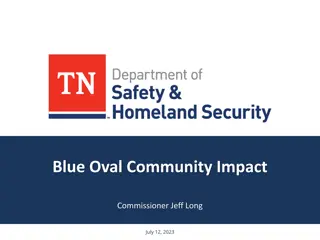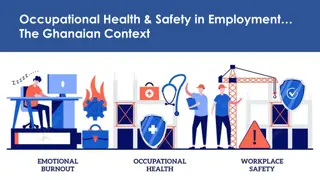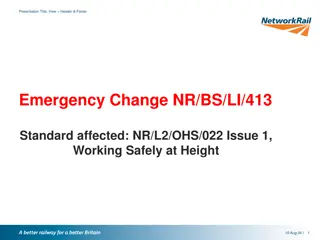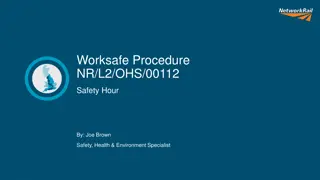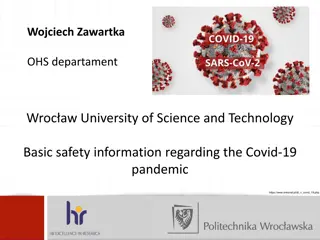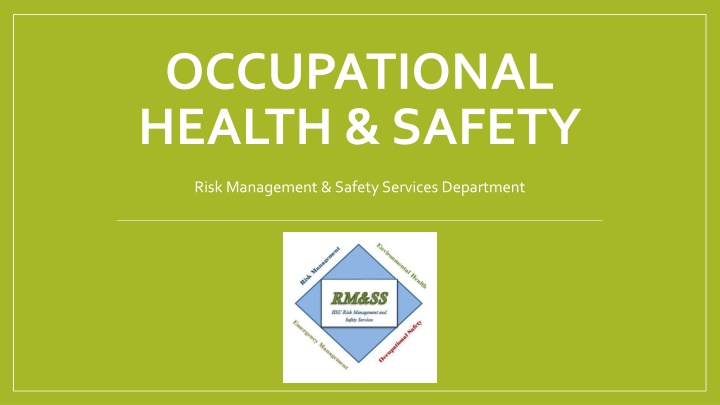
Occupational Health and Safety Risk Management Overview
Explore the importance of Occupational Health and Safety (OHS) in fostering a safe work environment, with a focus on hazard prevention, OSHA regulations, hazard controls, and proactive safety measures. Learn about the role of the OHS department in ensuring employee well-being and compliance with state and federal safety standards.
Download Presentation

Please find below an Image/Link to download the presentation.
The content on the website is provided AS IS for your information and personal use only. It may not be sold, licensed, or shared on other websites without obtaining consent from the author. If you encounter any issues during the download, it is possible that the publisher has removed the file from their server.
You are allowed to download the files provided on this website for personal or commercial use, subject to the condition that they are used lawfully. All files are the property of their respective owners.
The content on the website is provided AS IS for your information and personal use only. It may not be sold, licensed, or shared on other websites without obtaining consent from the author.
E N D
Presentation Transcript
OCCUPATIONAL HEALTH & SAFETY Risk Management & Safety Services Department
What is OHS and what do we do? To ensure a healthy and safe working environment for all employees. Prevention, elimination & mitigation of hazards throughout campus community which could result in injury or harm. Interpretation and delivery of documents, programs and training of state and federal regulation for HSU to provide a safe and healthy workplace for all employees. Programs this is not a comprehensive list: Health and Safety Committees Incident Investigation Ergonomics Workplace Inspections Lock out / Tag out Fall Protection Confined Spaces HazardAnalysis Shop Safety
The Rundown of OSHA Occupational Safety and Health Act of 1970 Enacted by Congress to reduce accidents, injuries, medical illnesses and death. Seems fairly important and easy to comprehend, but have you asked yourself what and why is this important to me as a worker or supervisor? OSHA can be overwhelming, lots of information that is not easy to absorb. Primary goal is foster and nourish a healthy and safe working environment for all individuals in the work field. 60% (deaths) & 40% (injuries & illnesses) reductions since creation of OSHA.
Regulation & EO Cal/OSHA Injury and Illness Prevention Program PPE Program (JHA) (2) The employer shall verify that the required workplace hazard assessment has been performed through a written certification that identifies the workplace evaluated; the person certifying that the evaluation has been performed; the date(s) of the hazard assessment; and, which identifies the document as a certification of hazard assessment. OSHA Penalties(State Plans) OSHA CSU Executive Order 1039 Collective Bargain Agreements
Proactive Vs. Reactive Somebody is going to get hurt over there That s an accident waiting to happen I ll be fine, my knee hurts, but I can still do my job. These situations could result in injuries or incidents to our coworkers, students, members of the public or ourselves. We want to capture information through Hazard Identification and Reporting of Deficiencies for prevention of future incidents. Providing controls to eliminate or mitigate the hazards in timely manner.
Hazard Controls Some control measures are more effective than others at reducing or eliminating hazards. Different types of controls normally carry benefits and limitations. First consideration of hazard control is eliminating the hazard or substitution of a less hazardous activity, material or process. An example: using water-based paint rather than solvent- based paint. This will minimize the flammability and eliminates the health hazard for employees.
Hazard Controls When it is not possible to eliminate the hazard or substitute the hazard: 1. Engineering controls 2. Administrative controls 3. Personal protective equipment Applying this hierarchy is a systematic approach to identify the most effective method of reducing the risk. We want to select the highest level of feasible control!
Question Poll Audience PPE questions, when do you use or what activities require PPE use.
Hazard Control What is the most effective method to control hazards? Ventilation system to control dust in a shop Employees are trained and signage is posted to warn of the hazards associated with the equipment. Safety glasses and gloves are required for the activity and equipment. 1. 2. 3.
Risk Probability Matrix IMPACT IMPACT Trivial Trivial Minor Minor Serious Serious Fatal Fatal Catastrophic Catastrophic Rare Rare Low Low Low Medium Medium PROBABILTY PROBABILTY Unlikely Unlikely Low Low Medium Medium Medium Moderate Moderate Low Medium Medium Medium High Likely Likely Medium Medium Medium High High Very Likely Very Likely Medium Medium High High High Definitions Definitions Impact Impact Trivial: Trivial: Minor abrasions, bruises, cuts, first aid type injuries. Minor: Minor: Disabling injury, but not permanent. Serious: Serious: Non-fatal injury, permanent disability. Fatal: Fatal: Approximately one fatality or major property damage. Catastrophic: Catastrophic: Numerous fatalities, irrecoverable property damage and productivity. Probability Probability Rare: Rare: Is practically impossible and has never occurred. Unlikely: Unlikely: Has not been known to occur for many years. Moderate: Moderate: Might occur sometime in the future. Likely: Likely: Has a good chance of occurring and is not unusual. Very Likely: Very Likely: The most likely result of the hazard/event being realized.
Important information to know Reporting injuries immediately serious injuries reported with 8 hours to Cal/OSHA or we will be fined by citation. Call EHS or WC. What do we need to be trained & educated for? Training may differed from position to position Trained to hazardous activities that they are LIKELY to encounter throughout their work day including; tasks, equipment, and environment. Carpenter vs. Dean of Art vs. Clinical Laboratory Scientist How do I get trained and what if we do not have the training available now? Frequency of training SkillPort & Canvas are on-line based modules for training purposes Classroom and practical training
What are some ways to start promoting safety in my area? Daily cleaning and maintenance Securing your workplace Prepared for emergencies Getting informed Staying equipped Attitude for the culture change Be the example Brother s keeper Participation for training and time





